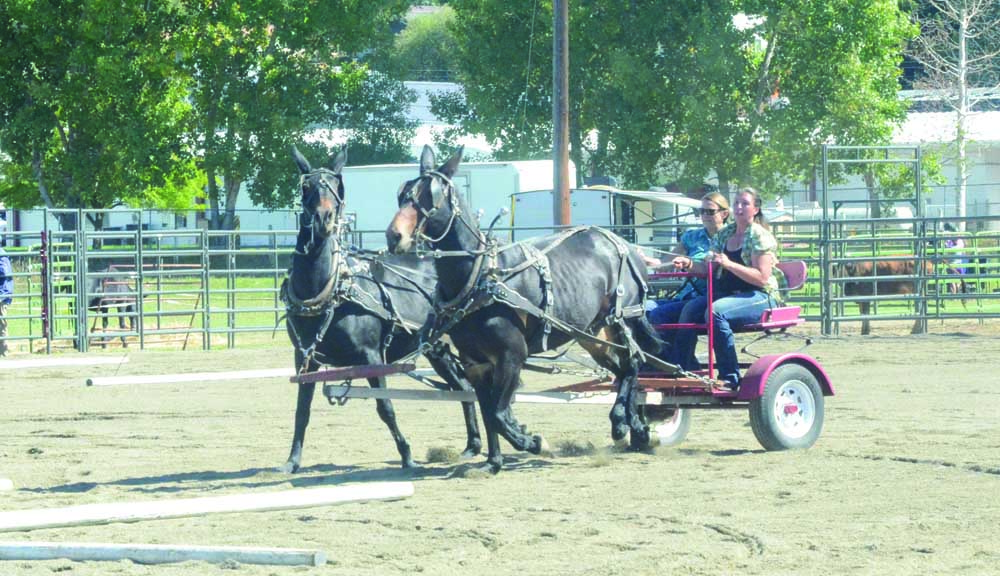‘Gee-Haw;” Handlers work hard to gain the trust of hardworking mules
Published 9:00 am Wednesday, September 13, 2023

- Suzanne Burkhart of Yamhill, right, drives a double-hitch cart team for the finish line Friday, Sept. 8, 2023, during the first day of Hells Canyon Mule Days.
ENTERPRISE — Respect, understanding and trust.
Those are key ingredients in being a muleskinner and handling mules, according to Suzanne Burkhart of Yamhill, a longtime participant in Hells Canyon Mule Days, who took a few minutes Saturday, Sept. 9, to talk about mules.
“They’re very, very hard workers,” she said. “I would say that they pick their people a lot more than a horse does. A horse will follow anybody. A mule will not. We have better relationships with our mules because they have to trust you in order to do whatever you want them to do.”
The horse-donkey hybrids have their advantages, Burkhart said.
“Mules are workers, so we use them for farming, wagon trains, we do a plowing competition every spring and we use them for a harvest festival in the fall,” she said.
That’s where the “gee” and “haw” commands come in. A muleskinner hollers “gee” to get the mule to pull to the right and “haw” to pull to the left. “Gee-haw” means straight ahead.
But they’re sterile
Burkart prefers mules to horses, though she likes both.
“We have horses — horses are good for making mules — we have both. It depends on what activity we’re doing,” she said.
A breeder can make two different types of the hybrids.
“A standard bred-mule is a mare horse and a jack donkey. That’s what most of these are,” she said, pointing to the mules around her. “You can do it the other way around where it’s a stud horse and a jenny donkey and that’s called a hinny. It’s just a different version of a mule. But they’re half-horse and half-donkey and they’re sterile so they don’t reproduce.”
The reason they’re sterile is based on biology.
According to www.luckythreeranch.com, a horse has 64 chromosomes and a donkey has 62. The mule ends up with 63. Mules can be either male or female, but because of the odd number of chromosomes, they can’t reproduce.
Most breeders prefer to have mules to hinnies.
Stubborn?
Mules have a well-deserved reputation for being stubborn, but it’s not so much out of orneriness as it is out of their intelligence.
According to www.allthingsnature.org/what-is-a-mule-skinner.htm, mules are famous for their high level of intelligence and obstinacy, and they can be difficult to handle as a result of these traits.
Burkhart agrees.
“A friend said a horse will accept you as its leader and a mule will demand that you give it a resume,” she said. “The idea is that when a mule stops and doesn’t do what you want it to, it’s because it thinks that it’s a bad idea. It will think a situation through before deciding to do it.”
To her, this indicates mules are “100% smarter” than horses.
With Burkhart at Mule Days was her boyfriend, Trampas Bergstrom.
“Yeah, Trampas, like in ‘The Virginian,’ he laughed.
“This is my guy right here and I dragged him here for the first time,” she said. “He’s a horse guy.”
Knowing both equines, Bergstrom is qualified to discuss their differences.
“After being around horses my entire life, they are completely different,” he said. “A mule will keep going until they physically can’t go anymore. A horse will tend to quit on you.”
He also agreed with Burkhart in how mules relate to people.
“She’s absolutely right,” he said. “Mules pick their people. It’s not usually a fast process.”
He also noted mules are much stronger than horses.
“They’re stronger per pound, per square inch,”
But they also form a strong attachment to a person.
“Also, they never forget anything,” she said. “If you mistreat them, they’re not forgiving in that department,” Burkhart said. “Once they know you and they trust you, then they’ll do anything for you. But it takes a bit to build that bond.”
Driving
A lot of the activity at Mule Days involved driving mules either single-hitch (one mule) or double-hitch (two mules.)
Burkhart said driving mules and horses is largely the same, but there are the differences characteristic of the breed.
“I think it’s the same principle, but they need to know that they’re serving a purpose, that they’re doing something for a good reason,” she said. “Driving a mule on a piece of equipment is pretty easy; they like to work. They put their heads down and they work hard.”
But when it comes to the less arduous activities a show horse may be asked to do, mules show their stubbornness.
“Probably driving in circles and doing ‘fluffy’ stuff, they’re not as inclined to do. Where a horse will literally go in circles in an arena for hours, these guys, they eventually get very bored very easily and they’ll just stop doing it,” she said. “The other day, we went in circles for maybe five minutes and then he just stopped.”
That’s where being a “muleskinner” comes in. A muleskinner is someone who specializes in handling mules, is experienced with mules and knows how to work with them to accomplish a goal.
Burkhart and Bergstrom weren’t planning to head right home as soon as Mule Days ended. They like Wallowa County enough they planned to camp here a few nights.
But then it’s off to Pendleton for the Pendleton Round-Up, which runs from Wednesday through Saturday, Sept. 13-16.
“Want to participate in their nonmotorized parade,” Burkhart said. “We go there and we lend our animals and our skills in driving in the parade every year.”


